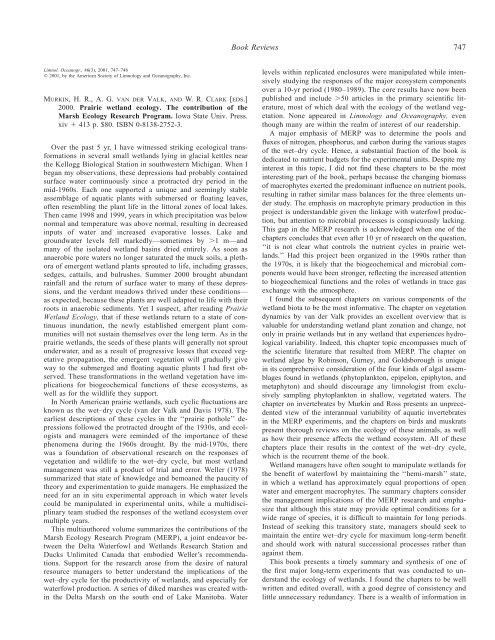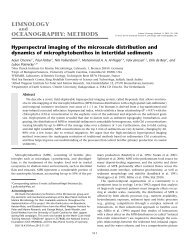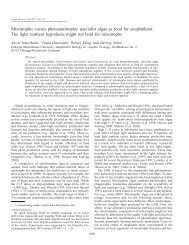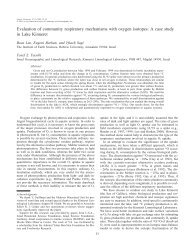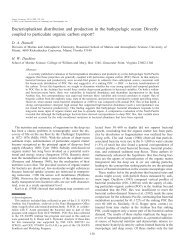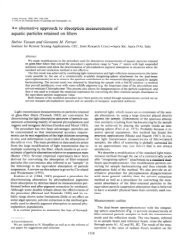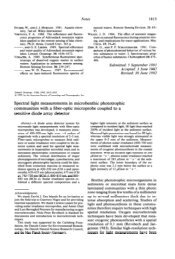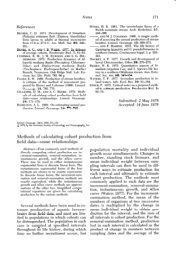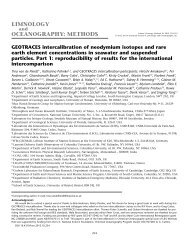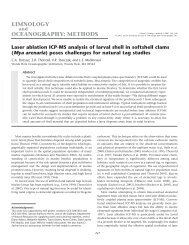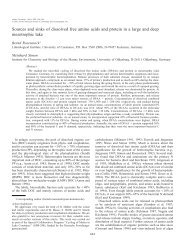Prairie wetland ecology. The contribution of the Marsh ... - ASLO
Prairie wetland ecology. The contribution of the Marsh ... - ASLO
Prairie wetland ecology. The contribution of the Marsh ... - ASLO
Create successful ePaper yourself
Turn your PDF publications into a flip-book with our unique Google optimized e-Paper software.
Book Reviews<br />
747<br />
Limnol. Oceanogr., 46(3), 2001, 747–748<br />
2001, by <strong>the</strong> American Society <strong>of</strong> Limnology and Oceanography, Inc.<br />
MURKIN, H. R., A. G. VAN DER VALK, AND W. R. CLARK [EDS.]<br />
2000. <strong>Prairie</strong> <strong>wetland</strong> <strong>ecology</strong>. <strong>The</strong> <strong>contribution</strong> <strong>of</strong> <strong>the</strong><br />
<strong>Marsh</strong> Ecology Research Program. Iowa State Univ. Press.<br />
xiv 413 p. $80. ISBN 0-8138-2752-3.<br />
Over <strong>the</strong> past 5 yr, I have witnessed striking ecological transformations<br />
in several small <strong>wetland</strong>s lying in glacial kettles near<br />
<strong>the</strong> Kellogg Biological Station in southwestern Michigan. When I<br />
began my observations, <strong>the</strong>se depressions had probably contained<br />
surface water continuously since a protracted dry period in <strong>the</strong><br />
mid-1960s. Each one supported a unique and seemingly stable<br />
assemblage <strong>of</strong> aquatic plants with submersed or floating leaves,<br />
<strong>of</strong>ten resembling <strong>the</strong> plant life in <strong>the</strong> littoral zones <strong>of</strong> local lakes.<br />
<strong>The</strong>n came 1998 and 1999, years in which precipitation was below<br />
normal and temperature was above normal, resulting in decreased<br />
inputs <strong>of</strong> water and increased evaporative losses. Lake and<br />
groundwater levels fell markedly—sometimes by 1 m—and<br />
many <strong>of</strong> <strong>the</strong> isolated <strong>wetland</strong> basins dried entirely. As soon as<br />
anaerobic pore waters no longer saturated <strong>the</strong> muck soils, a plethora<br />
<strong>of</strong> emergent <strong>wetland</strong> plants sprouted to life, including grasses,<br />
sedges, cattails, and bulrushes. Summer 2000 brought abundant<br />
rainfall and <strong>the</strong> return <strong>of</strong> surface water to many <strong>of</strong> <strong>the</strong>se depressions,<br />
and <strong>the</strong> verdant meadows thrived under <strong>the</strong>se conditions—<br />
as expected, because <strong>the</strong>se plants are well adapted to life with <strong>the</strong>ir<br />
roots in anaerobic sediments. Yet I suspect, after reading <strong>Prairie</strong><br />
Wetland Ecology, that if <strong>the</strong>se <strong>wetland</strong>s return to a state <strong>of</strong> continuous<br />
inundation, <strong>the</strong> newly established emergent plant communities<br />
will not sustain <strong>the</strong>mselves over <strong>the</strong> long term. As in <strong>the</strong><br />
prairie <strong>wetland</strong>s, <strong>the</strong> seeds <strong>of</strong> <strong>the</strong>se plants will generally not sprout<br />
underwater, and as a result <strong>of</strong> progressive losses that exceed vegetative<br />
propagation, <strong>the</strong> emergent vegetation will gradually give<br />
way to <strong>the</strong> submerged and floating aquatic plants I had first observed.<br />
<strong>The</strong>se transformations in <strong>the</strong> <strong>wetland</strong> vegetation have implications<br />
for biogeochemical functions <strong>of</strong> <strong>the</strong>se ecosystems, as<br />
well as for <strong>the</strong> wildlife <strong>the</strong>y support.<br />
In North American prairie <strong>wetland</strong>s, such cyclic fluctuations are<br />
known as <strong>the</strong> wet–dry cycle (van der Valk and Davis 1978). <strong>The</strong><br />
earliest descriptions <strong>of</strong> <strong>the</strong>se cycles in <strong>the</strong> ‘‘prairie pothole’’ depressions<br />
followed <strong>the</strong> protracted drought <strong>of</strong> <strong>the</strong> 1930s, and ecologists<br />
and managers were reminded <strong>of</strong> <strong>the</strong> importance <strong>of</strong> <strong>the</strong>se<br />
phenomena during <strong>the</strong> 1960s drought. By <strong>the</strong> mid-1970s, <strong>the</strong>re<br />
was a foundation <strong>of</strong> observational research on <strong>the</strong> responses <strong>of</strong><br />
vegetation and wildlife to <strong>the</strong> wet–dry cycle, but most <strong>wetland</strong><br />
management was still a product <strong>of</strong> trial and error. Weller (1978)<br />
summarized that state <strong>of</strong> knowledge and bemoaned <strong>the</strong> paucity <strong>of</strong><br />
<strong>the</strong>ory and experimentation to guide managers. He emphasized <strong>the</strong><br />
need for an in situ experimental approach in which water levels<br />
could be manipulated in experimental units, while a multidisciplinary<br />
team studied <strong>the</strong> responses <strong>of</strong> <strong>the</strong> <strong>wetland</strong> ecosystem over<br />
multiple years.<br />
This multiauthored volume summarizes <strong>the</strong> <strong>contribution</strong>s <strong>of</strong> <strong>the</strong><br />
<strong>Marsh</strong> Ecology Research Program (MERP), a joint endeavor between<br />
<strong>the</strong> Delta Waterfowl and Wetlands Research Station and<br />
Ducks Unlimited Canada that embodied Weller’s recommendations.<br />
Support for <strong>the</strong> research arose from <strong>the</strong> desire <strong>of</strong> natural<br />
resource managers to better understand <strong>the</strong> implications <strong>of</strong> <strong>the</strong><br />
wet–dry cycle for <strong>the</strong> productivity <strong>of</strong> <strong>wetland</strong>s, and especially for<br />
waterfowl production. A series <strong>of</strong> diked marshes was created within<br />
<strong>the</strong> Delta <strong>Marsh</strong> on <strong>the</strong> south end <strong>of</strong> Lake Manitoba. Water<br />
levels within replicated enclosures were manipulated while intensively<br />
studying <strong>the</strong> responses <strong>of</strong> <strong>the</strong> major ecosystem components<br />
over a 10-yr period (1980–1989). <strong>The</strong> core results have now been<br />
published and include 50 articles in <strong>the</strong> primary scientific literature,<br />
most <strong>of</strong> which deal with <strong>the</strong> <strong>ecology</strong> <strong>of</strong> <strong>the</strong> <strong>wetland</strong> vegetation.<br />
None appeared in Limnology and Oceanography, even<br />
though many are within <strong>the</strong> realm <strong>of</strong> interest <strong>of</strong> our readership.<br />
A major emphasis <strong>of</strong> MERP was to determine <strong>the</strong> pools and<br />
fluxes <strong>of</strong> nitrogen, phosphorus, and carbon during <strong>the</strong> various stages<br />
<strong>of</strong> <strong>the</strong> wet–dry cycle. Hence, a substantial fraction <strong>of</strong> <strong>the</strong> book is<br />
dedicated to nutrient budgets for <strong>the</strong> experimental units. Despite my<br />
interest in this topic, I did not find <strong>the</strong>se chapters to be <strong>the</strong> most<br />
interesting part <strong>of</strong> <strong>the</strong> book, perhaps because <strong>the</strong> changing biomass<br />
<strong>of</strong> macrophytes exerted <strong>the</strong> predominant influence on nutrient pools,<br />
resulting in ra<strong>the</strong>r similar mass balances for <strong>the</strong> three elements under<br />
study. <strong>The</strong> emphasis on macrophyte primary production in this<br />
project is understandable given <strong>the</strong> linkage with waterfowl production,<br />
but attention to microbial processes is conspicuously lacking.<br />
This gap in <strong>the</strong> MERP research is acknowledged when one <strong>of</strong> <strong>the</strong><br />
chapters concludes that even after 10 yr <strong>of</strong> research on <strong>the</strong> question,<br />
‘‘it is not clear what controls <strong>the</strong> nutrient cycles in prairie <strong>wetland</strong>s.’’<br />
Had this project been organized in <strong>the</strong> 1990s ra<strong>the</strong>r than<br />
<strong>the</strong> 1970s, it is likely that <strong>the</strong> biogeochemical and microbial components<br />
would have been stronger, reflecting <strong>the</strong> increased attention<br />
to biogeochemical functions and <strong>the</strong> roles <strong>of</strong> <strong>wetland</strong>s in trace gas<br />
exchange with <strong>the</strong> atmosphere.<br />
I found <strong>the</strong> subsequent chapters on various components <strong>of</strong> <strong>the</strong><br />
<strong>wetland</strong> biota to be <strong>the</strong> most informative. <strong>The</strong> chapter on vegetation<br />
dynamics by van der Valk provides an excellent overview that is<br />
valuable for understanding <strong>wetland</strong> plant zonation and change, not<br />
only in prairie <strong>wetland</strong>s but in any <strong>wetland</strong> that experiences hydrological<br />
variability. Indeed, this chapter topic encompasses much <strong>of</strong><br />
<strong>the</strong> scientific literature that resulted from MERP. <strong>The</strong> chapter on<br />
<strong>wetland</strong> algae by Robinson, Gurney, and Goldsborough is unique<br />
in its comprehensive consideration <strong>of</strong> <strong>the</strong> four kinds <strong>of</strong> algal assemblages<br />
found in <strong>wetland</strong>s (phytoplankton, epipelon, epiphyton, and<br />
metaphyton) and should discourage any limnologist from exclusively<br />
sampling phytoplankton in shallow, vegetated waters. <strong>The</strong><br />
chapter on invertebrates by Murkin and Ross presents an unprecedented<br />
view <strong>of</strong> <strong>the</strong> interannual variability <strong>of</strong> aquatic invertebrates<br />
in <strong>the</strong> MERP experiments, and <strong>the</strong> chapters on birds and muskrats<br />
present thorough reviews on <strong>the</strong> <strong>ecology</strong> <strong>of</strong> <strong>the</strong>se animals, as well<br />
as how <strong>the</strong>ir presence affects <strong>the</strong> <strong>wetland</strong> ecosystem. All <strong>of</strong> <strong>the</strong>se<br />
chapters place <strong>the</strong>ir results in <strong>the</strong> context <strong>of</strong> <strong>the</strong> wet–dry cycle,<br />
which is <strong>the</strong> recurrent <strong>the</strong>me <strong>of</strong> <strong>the</strong> book.<br />
Wetland managers have <strong>of</strong>ten sought to manipulate <strong>wetland</strong>s for<br />
<strong>the</strong> benefit <strong>of</strong> waterfowl by maintaining <strong>the</strong> ‘‘hemi-marsh’’ state,<br />
in which a <strong>wetland</strong> has approximately equal proportions <strong>of</strong> open<br />
water and emergent macrophytes. <strong>The</strong> summary chapters consider<br />
<strong>the</strong> management implications <strong>of</strong> <strong>the</strong> MERP research and emphasize<br />
that although this state may provide optimal conditions for a<br />
wide range <strong>of</strong> species, it is difficult to maintain for long periods.<br />
Instead <strong>of</strong> seeking this transitory state, managers should seek to<br />
maintain <strong>the</strong> entire wet–dry cycle for maximum long-term benefit<br />
and should work with natural successional processes ra<strong>the</strong>r than<br />
against <strong>the</strong>m.<br />
This book presents a timely summary and syn<strong>the</strong>sis <strong>of</strong> one <strong>of</strong><br />
<strong>the</strong> first major long-term experiments that was conducted to understand<br />
<strong>the</strong> <strong>ecology</strong> <strong>of</strong> <strong>wetland</strong>s. I found <strong>the</strong> chapters to be well<br />
written and edited overall, with a good degree <strong>of</strong> consistency and<br />
little unnecessary redundancy. <strong>The</strong>re is a wealth <strong>of</strong> information in
748 Book Reviews<br />
this book that applies to <strong>wetland</strong>s in general, and given its reasonable<br />
price, I feel that it deserves a spot in <strong>the</strong> library <strong>of</strong> any<br />
<strong>wetland</strong> scientist.<br />
W. K. Kellogg Biological Station and<br />
Department <strong>of</strong> Zoology<br />
Michigan State University<br />
Hickory Corners, Michigan 49060<br />
Stephen K. Hamilton<br />
References<br />
VAN DER VALK, A.G.,AND C. B. DAVIS. 1978. Role <strong>of</strong> seed banks<br />
in <strong>the</strong> vegetative dynamics <strong>of</strong> prairie glacial marshes. Ecology<br />
59: 322–335.<br />
WELLER, M. W. 1978. Management <strong>of</strong> freshwater marshes for wildlife,<br />
p. 267–284. In R. E. Good, D. F. Whigham, and R. L.<br />
Simpson [eds.], Freshwater <strong>wetland</strong>s: Ecological processes and<br />
management potential. Academic.


